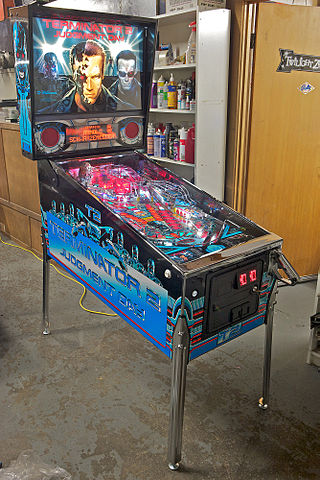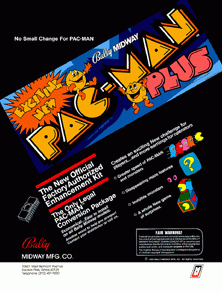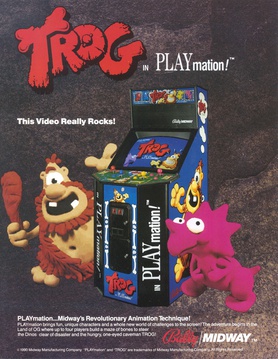
Pinball games are a family of games in which a ball is propelled into a specially designed table where it bounces off various obstacles, scoring points either en route or when it comes to rest. Historically the board was studded with nails called 'pins' and had hollows or pockets which scored points if the ball came to rest in them. Today, pinball is most commonly an arcade game in which the ball is fired into a specially designed cabinet known as a pinball machine, hitting various lights, bumpers, ramps, and other targets depending on its design. The game's object is generally to score as many points as possible by hitting these targets and making various shots with flippers before the ball is lost. Most pinball machines use one ball per turn, and the game ends when the ball(s) from the last turn are lost. The biggest pinball machine manufacturers historically include Bally Manufacturing, Gottlieb, Williams Electronics and Stern Pinball.

Pac-Man, originally called Puck Man in Japan, is a 1980 maze action video game developed and released by Namco for arcades. In North America, the game was released by Midway Manufacturing as part of its licensing agreement with Namco America. The player controls Pac-Man, who must eat all the dots inside an enclosed maze while avoiding four colored ghosts. Eating large flashing dots called "Power Pellets" causes the ghosts to temporarily turn blue, allowing Pac-Man to eat them for bonus points.

Ms. Pac-Man is a 1982 maze arcade video game developed by General Computer Corporation and published by Midway. It is the first sequel to Pac-Man (1980) and the first entry in the series to not be made by Namco. Controlling the title character, Pac-Man's wife, the player is tasked with eating all of the pellets in an enclosed maze while avoiding four colored ghosts. Eating the larger "power pellets" lets the player eat the ghosts, who turn blue and flee.

Pac-Man Plus is an arcade game that was released by Bally Midway in 1983. It is part of the Pac-Man series of games.

Jr. Pac-Man is an arcade video game developed by General Computer Corporation and released by Bally Midway on August 13, 1983. It has the same gameplay as prior entries in the series, but the maze in Jr. Pac-Man scrolls horizontally and has no escape tunnels. The bonus item which moves around the maze changes dots into a form which slows Jr. Pac-Man as they are being eaten.

Pac-Land is a 1984 side-scrolling arcade platform game developed and released by Namco. It was distributed in North America by Bally Midway, and in Europe by Atari Games. Controlling Pac-Man, the player must make it to the end of each stage to return a lost fairy back to its home in Fairyland. Pac-Man will need to avoid obstacles, such as falling logs and water-spewing fire hydrants, alongside his enemies, the Ghost Gang. Eating large flashing Power Pellets will cause the ghosts to turn blue, allowing Pac-Man to eat them for points.

WMS Industries, Inc. was an American electronic gaming and amusement manufacturer in Enterprise, Nevada. It was merged into Scientific Games in 2016. WMS's predecessor was the Williams Manufacturing Company, founded in 1943 by Harry E. Williams. However, the company that became WMS Industries was formally founded in 1974 as Williams Electronics, Inc.

Tron is a coin-operated arcade video game manufactured and distributed by Bally Midway in 1982. The game consists of four subgames inspired by the events of the Walt Disney Productions motion picture Tron released earlier in the summer. The lead programmer was Bill Adams. The music programmer was Earl Vickers.
1982 was the peak year for the golden age of arcade video games as well as the second generation of video game consoles. Many games were released that would spawn franchises, or at least sequels, including Dig Dug, Pole Position, Mr. Do!, Zaxxon, Q*bert, Time Pilot and Pitfall! The year's highest-grossing video game was Namco's arcade game Pac-Man, for the third year in a row, while the year's best-selling home system was the Atari 2600. Additional video game consoles added to a crowded market, notably the ColecoVision and Atari 5200. Troubles at Atari late in the year triggered the video game crash of 1983.
Fueled by the previous year's release of the colorful and appealing Pac-Man, the audience for arcade video games in 1981 became much wider. Pac-Man influenced maze games began appearing in arcades and on home systems. Pac-Man was the highest grossing video game for the second year in a row. Nintendo's Donkey Kong defined the platform game genre, while Konami's Scramble established scrolling shooters. The lesser known Jump Bug combined the two concepts into both the first scrolling platform game and the first platform shooter. Other arcade hits released in 1981 include Defender, Frogger, and the Galaxian sequel Galaga.

Rally-X is a maze chase arcade video game developed in Japan and Germany by Namco and released in 1980. In North America, it was distributed by Midway Manufacturing and in Europe by Karateco. Players drive a blue Formula One race car through a multidirectional scrolling maze to collect yellow flags. Boulders block some paths and must be avoided. Red enemy cars pursue the player in an attempt to collide with them. Red cars can be temporarily stunned by laying down smoke screens at the cost of fuel. Rally-X is one of the first games with bonus stages and continuously-playing background music.

Professor Pac-Man is a quiz arcade game that was produced by Bally Midway and is the seventh title in the Pac-Man series of games, which was released in August 1983. It is also the last of only seven games from Bally Midway Manufacturing to run on their Midway Astrocade hardware. Only 400 cabinets were made; approximately 300 of these were returned to the manufacturer and converted to Pac-Land cabinets the following year.

Checkpoint is a 1991 pinball machine released by Data East. It featured the first dot matrix display (DMD) ever incorporated into a pinball game. For Checkpoint, Data East used a "half-height" DMD. By way of comparison, Williams later produced machines with standard DMDs that were twice the height. Checkpoint also features video mode minigames on its display.

Trog is a maze arcade video game developed and published by Midway Manufacturing in 1990 in North America under the "Bally/Midway" label and later by Williams Electronics in Europe. In the game, players control one of four dinosaurs chased by the titular cavemen. Its gameplay includes elements of Pac-Man—collect all items in a maze, eat a special item to turn the tables on pursuers—but supports up to four players at once. Initially envisioned as a hybrid puzzle/strategy project, its original concept was later reworked into a Pac-Man-like title after poor reception from testers and features claymation graphics, advertised as "Playmation" by Midway. Conversions for the Nintendo Entertainment System and MS-DOS were released by Acclaim Entertainment in 1990 and 1991 respectively, reducing the number of simultaneous players to two. Both the arcade and NES versions garnered positive reception from critics.

Bally Manufacturing, later renamed Bally Entertainment, was an American company that began as a pinball and slot machine manufacturer, and later expanded into casinos, video games, health clubs, and theme parks. It was acquired by Hilton Hotels in 1996.

The Party Zone is a crossover solid-state pinball machine released in 1991 by Midway designed by Dennis Nordman and programmed by Jim Strompolis. It is in a single playfield format and collaborates characters from previous pinball machines. It is the second pinball machine released after the Bally-Midway division was sold, yet still operated under the "Bally" name.

The Pinball Arcade is a pinball video game developed by FarSight Studios. The game is a simulated collection of 100 real pinball tables licensed by Gottlieb, Alvin G. and Company, and Stern Pinball, a company which also owns the rights of machines from Data East and Sega Pinball. Williams and Bally games are no longer available since June 30, 2018, as FarSight had lost the license to WMS properties, which has since passed to Zen Studios.















